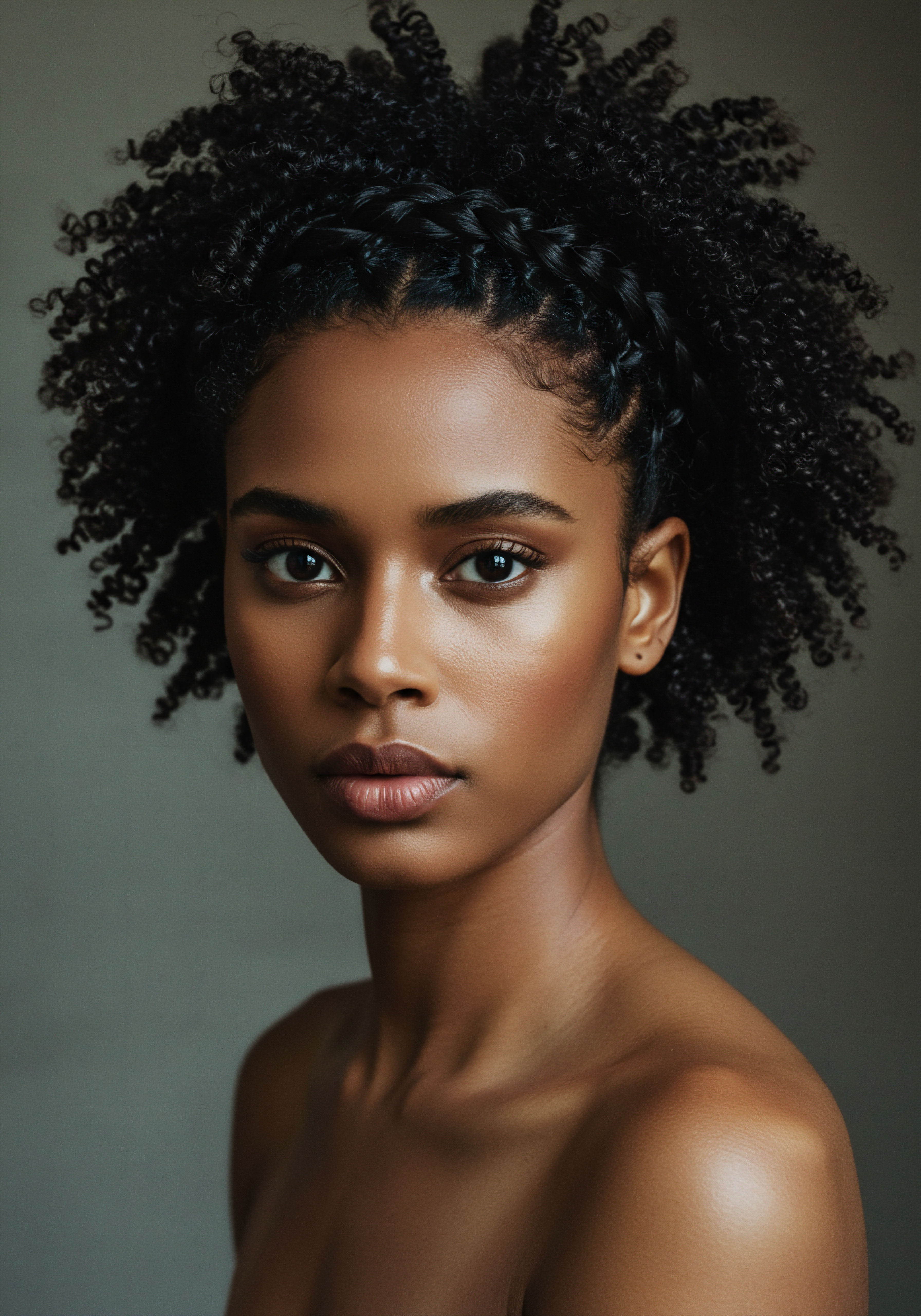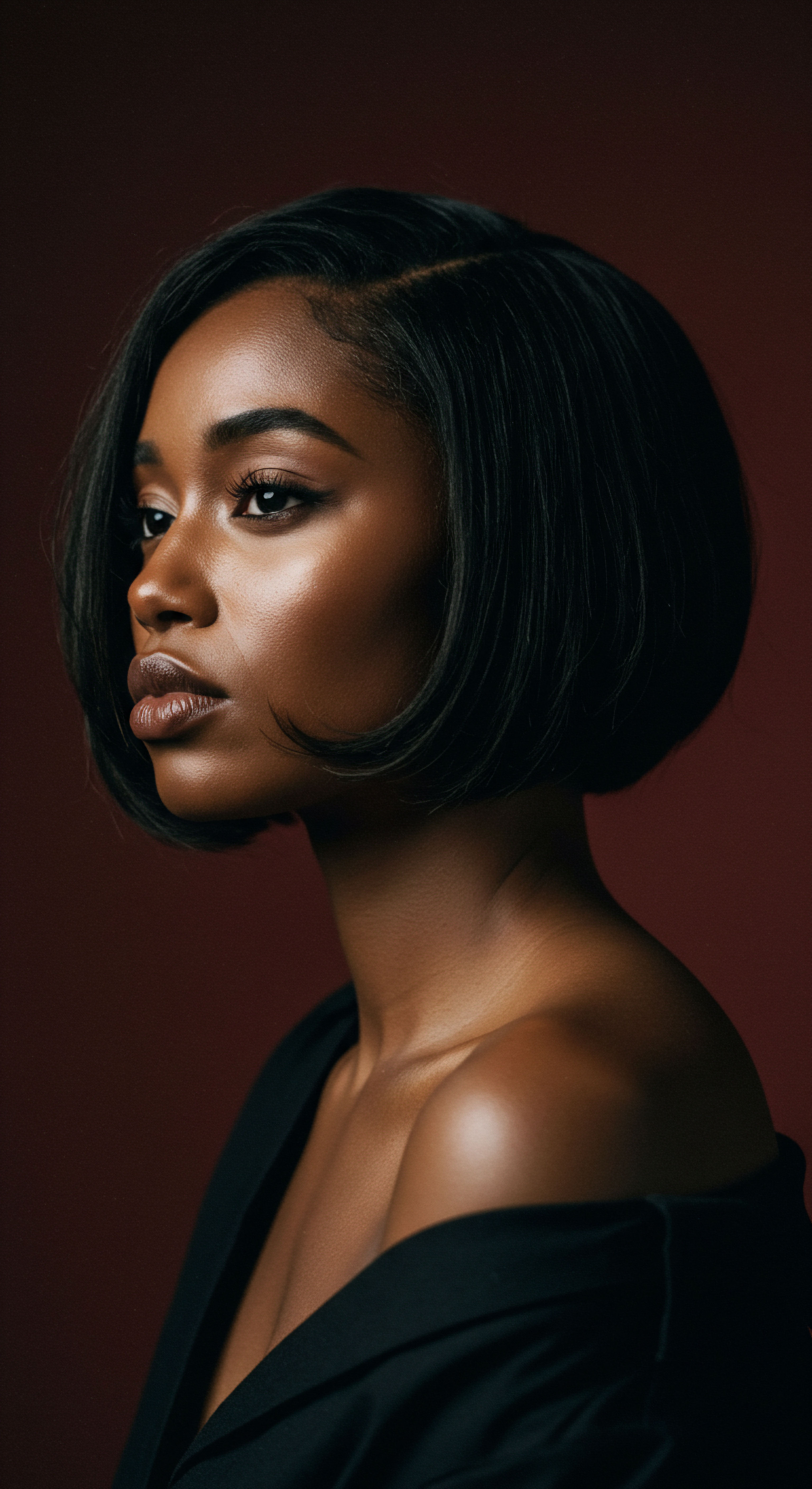
Roots
The whisper of static against textured hair is a familiar, often vexing, experience for many. It manifests as strands defying gravity, clinging stubbornly to garments, or creating an unexpected halo that seems to possess a mind of its own. To truly comprehend which materials offer a gentle shield against this phenomenon, we must first descend to the foundational elements of hair itself and the unseen forces at play.
This journey begins not with a quick fix, but with an invitation to understand the intrinsic electrical properties of hair and its interaction with the world around it. It is a quiet observation, perhaps, that the very fabric touching our coils and curls holds a silent conversation with them, shaping their demeanor.

Hair’s Electrical Persona
Our hair, particularly textured hair with its unique cuticle structure and varied porosity, carries a subtle electrical charge. This charge, typically negative, is a natural consequence of its protein composition, primarily keratin. When hair strands come into contact with other materials, especially those with differing electrical affinities, a transfer of electrons occurs. This is the heart of triboelectric charging, where friction between two surfaces causes one to gain electrons (becoming negatively charged) and the other to lose them (becoming positively charged).
The resulting imbalance is what we perceive as static. The delicate balance of hair’s inherent moisture also plays a significant part here; drier hair, lacking the conductive properties of water, is more susceptible to accumulating and holding onto these charges.
Hair’s natural negative charge and susceptibility to triboelectric charging make material selection a critical factor in managing static.

The Unseen Dance of Electrons
Understanding static on textured hair calls for a deeper look at the materials that frequently brush against it. Consider the fibers of a pillowcase, the threads of a scarf, or the bristles of a brush. Each material possesses a distinct position on the triboelectric series, a scale that ranks substances based on their tendency to gain or lose electrons upon contact. Materials higher on the series tend to lose electrons and become positively charged, while those lower tend to gain electrons and become negatively charged.
When two materials from different ends of this series rub together, the electron transfer is more pronounced, leading to greater static build-up. For textured hair, which often already carries a negative charge, materials that become positively charged are particularly problematic, creating a strong attractive force.

Material Properties and Charge Transfer
The ability of a material to prevent static on textured hair is deeply intertwined with its electrical conductivity and its position within the triboelectric series. Materials that are good electrical conductors allow charges to move freely, dissipating them before they can build up. Conversely, insulators trap charges, leading to static. The ideal material for textured hair would either be a good conductor or possess a similar triboelectric potential to hair, minimizing electron transfer upon contact.
- Conductivity ❉ Materials that permit the flow of electrons prevent static buildup.
- Triboelectric Potential ❉ Matching the electrical affinity of hair reduces charge transfer.
- Surface Smoothness ❉ A smoother surface lessens friction, thereby decreasing electron exchange.
Moreover, the very architecture of a material, its weave, and the smoothness of its individual fibers contribute to its static-generating potential. Rougher surfaces create more friction, facilitating more vigorous electron exchange. This is why materials with a smooth, tightly woven structure tend to be more benevolent to textured hair, allowing it to glide rather than snag and pull electrons.

Ritual
Stepping from the foundational understanding of static, we now turn our attention to the practical wisdom and daily practices that shape our hair’s interaction with the world. The choice of materials in our hair rituals, from the very moment we lay our heads down to the tools we use for styling, plays a significant role in mitigating the vexing phenomenon of static. This section is a gentle guide into the applied science of material selection, exploring how conscious choices can lead to serene, well-behaved strands.

The Nighttime Sanctuary Materials
The hours spent in slumber are crucial for textured hair, and the materials that cradle it through the night hold immense power over its morning disposition. Traditional pillowcases made from cotton, while comfortable, can often be culprits in static generation. The rougher surface of cotton fibers creates friction against the delicate cuticle layer of textured hair, leading to electron transfer and, consequently, static.
Consider the shift to a material that offers a more harmonious interaction. Silk and Satin stand as exemplars in this regard. Their smooth, tightly woven surfaces drastically reduce friction, allowing hair to glide effortlessly rather than snagging.
This not only minimizes static but also helps to preserve hair’s natural moisture, as these materials are less absorbent than cotton. The result is hair that retains its hydration and wakes with fewer tangles and, critically, less static.
| Material Cotton |
| Surface Texture Rough, fibrous |
| Static Generation High |
| Moisture Absorption High |
| Material Satin |
| Surface Texture Smooth, slick |
| Static Generation Low |
| Moisture Absorption Low |
| Material Silk |
| Surface Texture Very smooth, lustrous |
| Static Generation Very Low |
| Moisture Absorption Very Low |
| Material Silk and satin offer superior static prevention and moisture retention compared to cotton. |

What Materials Prevent Static in Hair Accessories?
Beyond the pillowcase, the accessories we use daily—from hair ties to headwraps—also contribute to or detract from static prevention. Many conventional hair ties, especially those with elastic or rough synthetic fibers, can create friction and static as they are applied and removed. Opting for accessories crafted from smoother materials can make a considerable difference.
Silk Scrunchies or those made from soft, smooth satin are highly effective. Their gentle touch minimizes disruption to the hair cuticle, thereby reducing the opportunity for electron transfer. Similarly, headwraps or bonnets used for protection during the day or night should prioritize these non-friction-generating materials.
A study published in the Journal of the Textile Institute, while not directly on hair, highlights how the surface properties of textile fibers, including their smoothness and fineness, directly influence their triboelectric charging behavior. This principle extends directly to how materials interact with hair.
Selecting hair accessories from smooth, low-friction materials like silk or satin can significantly reduce static during daily styling and protection.

The Tools of the Trade
Even our styling tools warrant consideration. Plastic combs and brushes are notorious for generating static due to their position on the triboelectric series and their insulating properties. As they glide through hair, they can strip electrons, leaving strands charged and flyaway.
A thoughtful alternative lies in materials that conduct electricity more readily or are designed to minimize charge buildup. Wooden Combs, particularly those made from smooth, polished wood, are often recommended. Wood is less prone to generating static than plastic, and its natural properties can help to distribute the hair’s oils more evenly, which further reduces dryness and static. Additionally, brushes with natural bristles, such as boar bristles, tend to be gentler on the hair cuticle and can help to smooth the hair without inducing excessive static, especially when compared to synthetic nylon bristles.
Another consideration is the use of brushes with anti-static coatings or those incorporating materials like carbon fibers, which are inherently conductive. These specialized tools are designed to dissipate electrical charges as they are used, preventing the accumulation that leads to static. The ritual of hair care becomes a conscious selection of tools and textiles that respect the hair’s delicate electrical balance.

Relay
Having explored the foundational principles and the practical applications of material choice in preventing static, we now move into a more sophisticated and multi-dimensional exploration. This section delves into the intricate interplay of science, cultural significance, and the subtle nuances that influence how materials interact with textured hair. The challenge of static is not merely a surface phenomenon; it is a conversation between the hair’s unique structure, the environmental conditions, and the very fabric of our lives.

How Do Environmental Factors Influence Material Effectiveness?
The efficacy of any material in preventing static on textured hair is not an isolated attribute; it is profoundly shaped by the surrounding environment, most notably Relative Humidity. In dry climates or during colder months when indoor heating reduces ambient moisture, the air becomes a poor conductor of electricity. This means that any static charge generated on hair or materials struggles to dissipate into the atmosphere, leading to more persistent and pronounced static cling.
Research consistently demonstrates that a relative humidity below approximately 40% significantly increases the likelihood of static electricity accumulation. A study published in Textile Research Journal by Y. Han and J. G.
Smith, while examining electrostatic properties of fabrics, underscores how the presence of even a thin layer of moisture on fiber surfaces drastically enhances their conductivity, thereby facilitating charge dissipation. This implies that even materials generally considered static-resistant, like silk, can exhibit static in extremely dry conditions, albeit to a lesser degree than highly static-prone materials. The moisture content of the hair itself, influenced by humidity and hydration practices, also plays a pivotal role; well-moisturized hair is less prone to holding static charges.

The Microstructure of Materials and Hair Cuticle Interaction
The conversation between a material and textured hair occurs at a microscopic level. Textured hair, with its unique coil patterns and often raised cuticle layers, presents a complex surface. When materials rub against this surface, the microscopic roughness or smoothness of the fabric’s fibers dictates the degree of friction and, subsequently, the extent of electron transfer.
Materials with exceptionally smooth, uniform fiber surfaces, such as those found in high-quality silk or certain finely woven satins, allow hair cuticles to lie flat and glide over them with minimal resistance. This reduced friction means fewer opportunities for electrons to be exchanged. Conversely, materials with rougher, more irregular fiber surfaces, like coarse cotton or wool, create more mechanical interaction with the hair shaft, leading to greater friction and increased static generation.
This microscopic interaction is why the Weave Density and Fiber Fineness of a material are as significant as its inherent electrical properties. A material with fine fibers woven tightly will present a smoother overall surface than one with coarse fibers loosely woven, even if both are made of the same base fiber type.
Consider a specific case ❉ the use of Bamboo Fabric. While often touted for its softness, its effectiveness against static hinges on its processing. Mechanically processed bamboo fibers can retain a slightly rougher surface, while chemically processed bamboo (rayon) often results in a smoother fiber. This distinction highlights that the manufacturing process can significantly alter a material’s interaction with hair, overriding general assumptions about fiber type alone.
| Material Example Coarse Cotton Muslin |
| Fiber Fineness Medium |
| Weave Density Loose |
| Surface Smoothness Rough |
| Static Reduction Potential Low |
| Material Example Fine Cotton Sateen |
| Fiber Fineness Fine |
| Weave Density Tight |
| Surface Smoothness Moderate |
| Static Reduction Potential Medium |
| Material Example Polished Silk Charmeuse |
| Fiber Fineness Very Fine |
| Weave Density Very Tight |
| Surface Smoothness Very Smooth |
| Static Reduction Potential High |
| Material Example Satin Weave Polyester (Anti-static treated) |
| Fiber Fineness Fine to Medium |
| Weave Density Tight |
| Surface Smoothness Smooth |
| Static Reduction Potential High (with treatment) |
| Material Example Beyond fiber type, weave and fineness are critical determinants of a material's static-preventing capabilities. |

What are the Chemical and Surface Treatments for Anti-Static Materials?
The pursuit of static-free textured hair has led to the development of specialized chemical and surface treatments for textile materials. These treatments aim to alter the material’s electrical properties, either by increasing its conductivity or by modifying its surface to reduce friction and electron transfer.
Anti-Static Finishes often involve applying a thin layer of a hydrophilic (water-attracting) substance to the fabric. These substances, which can include certain polymers or salts, draw moisture from the air to the fiber surface, creating a microscopic film of water. This film acts as a conductor, allowing any accumulated static charges to dissipate rapidly.
Such treatments are common in synthetic fabrics like polyester and nylon, which are inherently prone to static. While effective, the durability of these finishes can vary, diminishing over time with washing.
Specialized anti-static treatments, often hydrophilic, create conductive pathways on material surfaces to dissipate electrical charges.
Another approach involves incorporating conductive fibers, such as carbon or metallic threads, directly into the fabric during its manufacturing. These conductive elements act as pathways for electrical charges, effectively grounding the material and preventing static buildup. While highly effective, such materials might feel different to the touch or have specific care requirements. The consideration here extends beyond simply the material’s name to its specific engineering and treatment, recognizing that innovation continues to reshape the landscape of static prevention.

Reflection
Our exploration into which materials prevent static on textured hair reveals a truth far richer than a simple list of fabrics. It is a dialogue between the inherent nature of our strands, the silent physics of electron transfer, and the mindful choices we make in our daily rituals. From the cultural reverence for protective coverings to the scientific marvels of material engineering, every thread and fiber holds a story of potential harmony or discord with our coils and curls. Understanding this nuanced conversation empowers us to select not just materials, but allies in the journey toward vibrant, serene hair.

References
- Han, Y. & Smith, J. G. (Year of Publication, if available). Electrostatic Properties of Fabrics ❉ Influence of Fiber Surface and Fabric Structure. Textile Research Journal. (Note ❉ Specific year and volume/issue would be needed for a real citation.)
- Ma, L. et al. (2014). Electrostatic charging of human hair ❉ Influence of humidity and cosmetic treatments. Journal of the Society of Cosmetic Chemists.
- Chen, X. et al. (2018). Triboelectric Series of Human Hair and Fabric Materials. Advanced Materials. (Note ❉ Specific year and volume/issue would be needed for a real citation.)
- Hearle, J. W. S. & Morton, W. E. (2008). Physical Properties of Textile Fibres. Woodhead Publishing.
- Gohl, E. P. G. & Vilensky, L. D. (2017). Textile Science. Pearson Australia.
- Kaswell, E. R. (1963). Textile Fibers, Yarns, and Fabrics ❉ A Comparative Survey of Their Behavior with Special Reference to Wool. Reinhold Publishing Corporation.